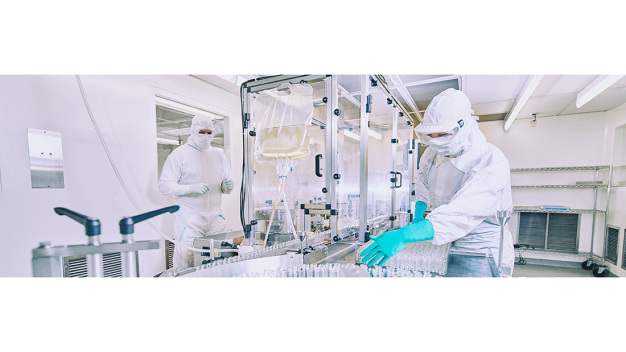- PSA
Gaelle Ramu
Cut protection in a sterile environment
In general, apparel for cleanrooms and sterile environments is designed purely to minimize particulate contamination of the surrounding environment. As a result, cleanroom personnel working with sharp equipment or glassware are at an increased risk of personal injury due to the lack of physical protection provided by standard cleanroom gloves. Engineers and workers servicing equipment in cleanrooms must also wear cleanroom-approved apparel, which can prevent them from properly protecting their hands from cut hazards. In this article we take a look at cut hazards in cleanroom and controlled environments, and how these can be minimized by sterile cut-resistant liners.
The function of a cleanroom is to keep the level of particulates to a minimum.1
Personnel working in cleanroom each represent a significant source of particulate contamination.2 Specialized cleanroom clothing is developed to minimize these effects: Typical cleanroom attire includes an ultra-clean coverall with hood, overboots, and an inner and outer layer of gloves. These garments are used to prevent contamination of the cleanroom during normal operation, so are designed with specific regard to properties such as particle generation, particle filtration, and resistance to wear.3
However, as a result of these stringent requirements, cleanroom clothing and gloves generally offer little in the way of cut protection for personnel handling glassware and other sharp apparatus that can easily pierce the thin material.
Cleanroom Cut Hazards
While adhering carefully to best procedures can minimize the risk of cleanroom injuries (for example, inserting a bung into a glass test tube safely), it’s impossible to eliminate this risk entirely. The first international survey of researchers’ workplace attitudes and practices, conducted in 2013, revealed that lab workers routinely overestimate their workplace safety: 86% of respondents said their labs were safe places to work, yet close to half had been injured in the lab.4 The most common injuries were cuts, lacerations and needle pricks.
For example, in the fields of pharmaceutical manufacturing and biotechnology, cleanroom personnel are routinely required to load and unload process equipment, clean glassware and sharps, and carry out cleanroom preparation. All of these tasks present a cut hazard. It’s not only needles and equipment with existing sharp edges that poses a risk: any breakable equipment, especially glassware, has the potential to cause injury.
In the medical device industry, assembly of devices containing sharp components is similarly unsafe when wearing only cleanroom gloves. Again, these risks are not always obvious: while tools and devices such as scalpels and curettes are sharp by design, other components such as small wires and sharp glass edges present a more insidious risk of injury to lab workers.
In the microelectronics industry, a number of potentially injurious procedures are carried out in a cleanroom environment, including the cleaning of production stamps, wafer etch chemical processing, and FAB equipment maintenance and cleaning. Nearly every production job in this industry involves the use of hazardous chemicals for cleaning, stripping or degreasing parts and equipment. In environments such as these, cuts have an increased risk of contamination with dangerous substances such as acids, alkalis, polychlorinated biphenyls (PCBs) and solvents; which pose a risk to the entire body.5
Lack of cut protection is also problematic for engineers responsible for cleaning and maintaining equipment within cleanrooms. Since the machines used in cleanrooms are often constructed within the cleanroom and are not designed to be removed, upkeep of these machines must be carried out by personnel wearing cleanroom compatible clothing. A cleanroom environment is no place for ordinary protective gloves, and standard cleanroom gloves do not provide adequate cut protection when working with machinery.
It’s crucial, therefore, that clothing worn within cleanrooms can provide adequate protection to personnel working with cut risks while also meeting the required levels of cleanliness.
Cut-resistant glove liners for cleanroom environments
In order to protect cleanroom personnel against cut hazards, Ansell have developed BioCleanTM S-BCRL glove liners. These are sterile cut-resistant liners designed to be worn between two standard cleanroom gloves.6 Woven with Dyneema® Diamond yarn, they offer EN 338 and ANSI A2 cut protection for researchers/operators working with apparatus or equipment that poses a moderate cut risk, whilst maintaining aseptic protocol in a controlled environment.
The glove liners are both powder- and latex-free to prevent any latex allergies, as well as the chance of contamination that arises from powder. This is a significant advantage over other cut resistant liners that are often not up to cleanroom standards and are packaged in paper, which is itself high in particles. BioCleanTM‑ S-BCRL gloves are packaged in individual EasyTear polyethylene wallets for convenience and cleanliness.
By blending spandex with an ultrahigh molecular weight polyethylene, the BioCleanTM S-BCRL gloves are lightweight and comfortable, whilst still providing the same cut resistance as other, thicker, less comfortable types.
If you work in an aseptic cleanroom or controlled environment, and are regularly facing cutting and laceration risks, consider BioClean cut resistant liners.
References and Further Reading
1. Ohring, M. & Kasprzak, L. Reliability and failure of electronic materials and devices. Reliability and Failure of Electronic Materials and Devices (Elsevier Inc., 2014). doi:10.1142/9789812702876_0011
2. Hu, S. C. & Shiue, A. Validation and application of the personnel factor for the garment used in cleanrooms. Data Br. 6, 750–757 (2016).
3. Reinmüller, B. & Ljungqvist, B. Modern cleanroom clothing systems: People as a contamination source. PDA J. Pharm. Sci. Technol. 57, 114–125 (2003).
4. Van Noorden, R. Safety survey reveals lab risks. Nature 493, 9–10 (2013).
5. Safety & health guide for the microelectronics industry - Google Books. Available at: https://books.google.fr/books?id=PpwYRCHgG6EC&pg=PA4&lpg=PA4&dq=cut+hazard+microelectronics&source=bl&ots=l2L7xtiExP&sig=ACfU3U1rhCkU-q2QEzhbg6NNS1T2mrRcag&hl=en&sa=X&ved=2ahUKEwjC-4_R96PoAhUqz4UKHZvPARkQ6AEwAXoECA0QAQ#v=onepage&q=cut hazard microelectronics&f=false. (Accessed: 18th March 2020)
Ansell GmbH
81829 München
Germany









